How to See the Liberty Bell...in Queens
A copy of the famous American bell can be found inside a bank, which itself is modeled after Independence Hall!

The best of New York City’s past and an ambitious vision for its future are embodied in the architecture and art installations of the new Moynihan Train Hall. Housed inside the former James A. Farley Post Office, the new station serves as an extension of Penn Station for Long Island Railroad and Amtrak commuters. Opened in 1912, the building has been transformed into a modern transit hub fit for 21st-century travelers. The station’s public art program, commissioned by Empire State Development and developed by the Public Art Fund, includes three new site-specific installations, from world-famous artists, that carry out the station’s theme of mixing the old with the new. You can see the art and explore Moynihan Train Hall on one of our upcoming Remnants of Penn Station walking tours.
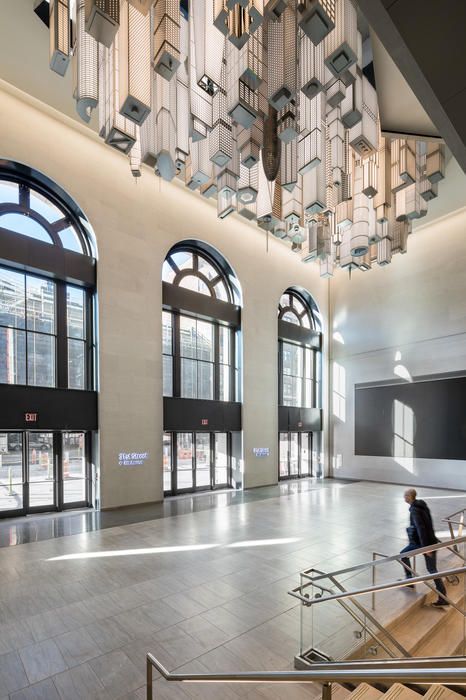 Elmgreen & Dragset, The Hive, 2020 Stainless steel, aluminum, polycarbonate, LED lights, and lacquer Commissioned by Empire State Development in partnership with Public Art Fund for Moynihan Train HallPhoto: Nicholas Knight, courtesy Empire State Development and Public Art Fund, NY
Elmgreen & Dragset, The Hive, 2020 Stainless steel, aluminum, polycarbonate, LED lights, and lacquer Commissioned by Empire State Development in partnership with Public Art Fund for Moynihan Train HallPhoto: Nicholas Knight, courtesy Empire State Development and Public Art Fund, NY
The first piece that greets you as you enter Moynihan Train Hall’s 31st Street entrance is The Hive. Created by the artist duo of Michael Elmgreen and Ingar Dragset, The Hive is a fantastical inverted cityscape inspired by iconic buildings of cities around the world including New York, Chicago, Hong Kong, Kuala Lumpur, London, and Paris. Elmgreen and Dragset have populated their fictional metropolis with buildings of their own creation and distilled versions of global landmarks.
The illuminated stainless steel and aluminum structures hang from the ceiling like stalactites. The comparison is intentional and meant to symbolize the evolution of human shelter from cave dwellings to the sprawling urban cities we have today. The name of the piece, also has meaning. The Hive compares the human-built cityscape to the complex and ever-changing architecture of a beehive, suggesting that cities too are constantly evolving. The hybrid of fictional and abstract buildings from around the world show that all cities of the world are connected.
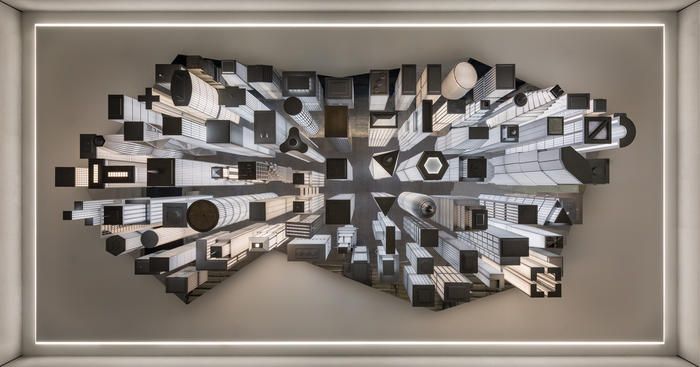
Elmgreen & Dragset, The Hive, 2020 Stainless steel, aluminum, polycarbonate, LED lights, and lacquer Commissioned by Empire State Development in partnership with Public Art Fund for Moynihan Train HallPhoto: Nicholas Knight, courtesy Empire State Development and Public Art Fund, NY
Stretching to heights of up to nine-feet tall, Elmgreen and Dragset’s miniature skyscrapers give viewers a new perspective. Though they weigh a hefty 30,000 pounds, the structures appear weightless as they are lit up by 72,000 LEDs light. A mirrored baseplate reflects the viewer below, placing you in the floating fictional city. The Hive is Elmgreen and Dragset’s first permanent public sculpture in New York City.
Keep looking up and you will discover Kehinde Wiley’s Go at Moynihan’s 33rd Street midblock entrance. The site-specific installation is a backlit, hand-painted, stained-glass triptych inspired by 18th-century European ceiling frescoes. Wiley, known for taking well-known styles and pieces of art and giving them a modern twist, takes this classical painting style and mixes it with modern Black culture in New York City. Instead of seeing winged-cherubs, saints, and people in togas like you might expect in a European fresco, Wiley populates his paintings with young Black New Yorkers in contemporary clothing. The subjects are in poses inspired by the movement of break-dancing, a dance style that originated on the streets of New York City.
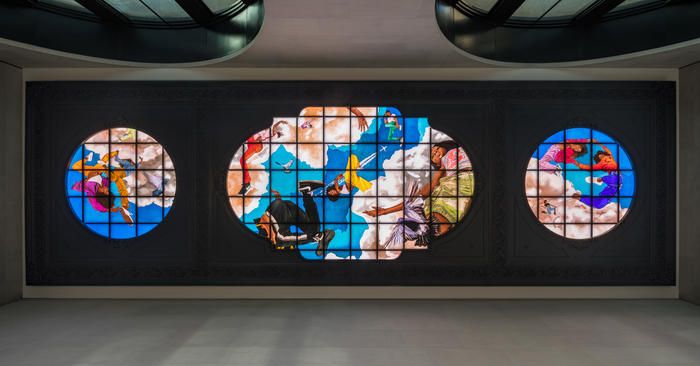
Go, 2020 © Kehinde Wiley. An original work of art commissioned by Empire State Development in partnership with Public Art Fund for Moynihan Train Hall. Photographer: Nicholas Knight. Image courtesy of the Artist, Sean Kelly, New York, Empire State Development and Public Art Fund, NY
In crop tops, Nike sneakers, hoodies and tracksuits, Wiley’s subjects joyously float through a sky filled with clouds, pigeons, and a jet plane. This contemporary imagery is painted using a technique associated with 18th-century master Giovanni Battista Tiepolo to create a “surrealist dreamscape that advances a narrative of buoyancy, possibility, and survival” says the Public Art Fund. The scene is framed by metalwork which takes cues from the historic metalwork found around the windows of the station. Go is the first permanent, site-specific installation in glass created by Wiley, who is most famous for his portrait of President Barack Obama.
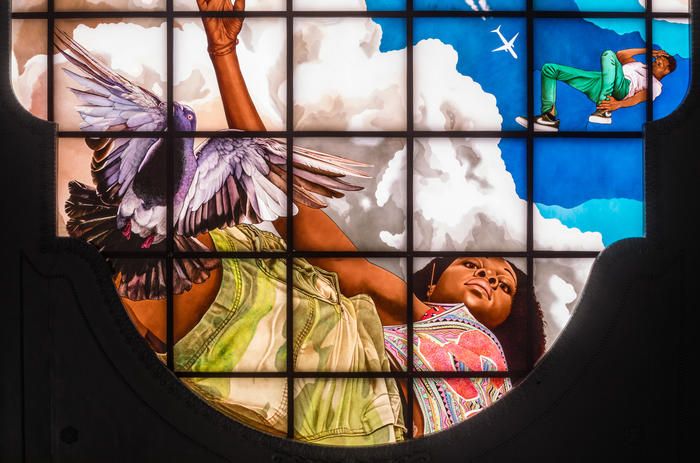
Go, 2020 © Kehinde Wiley. An original work of art commissioned by Empire State Development in partnership with Public Art Fund for Moynihan Train Hall. Photographer: Nicholas Knight. Image courtesy of the Artist, Sean Kelly, New York, Empire State Development and Public Art Fund, NY
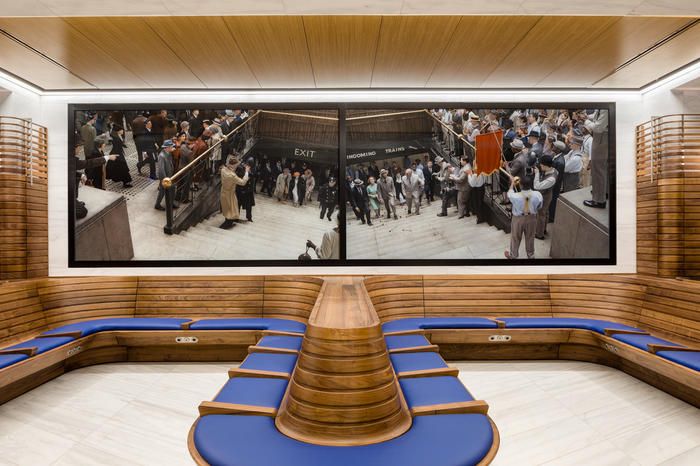
22 April 1924 and 7 August 1934, from Penn Station’s Half Century, 2020 Ceramic ink on glass. One of nine photographic panels from Penn Station’s Half Century Commissioned by Empire State Development in partnership with Public Art Fund for Moynihan Train Hall ©Stan Douglas. Courtesy of the artist, Victoria Miro and David Zwirner.
The final permanent installation can be found in the Ticketing Room, next to the sun-soaked atrium. Designed by the Rockewell Group, this waiting area features wooden seating and light fixtures inspired by the original McKim, Mead and White designed Penn Station. Stan Douglas’ photo series, Penn Station’s Half Century covers 80 feet of the waiting room wall. The installation consists of four photographs that “capture the serendipity and poignancy of daily life.” Displayed on 22-foot-long wall panels, Douglas’ photographs feature live actors in period costume set amongst digitally recreated interiors of the demolished Penn Station.
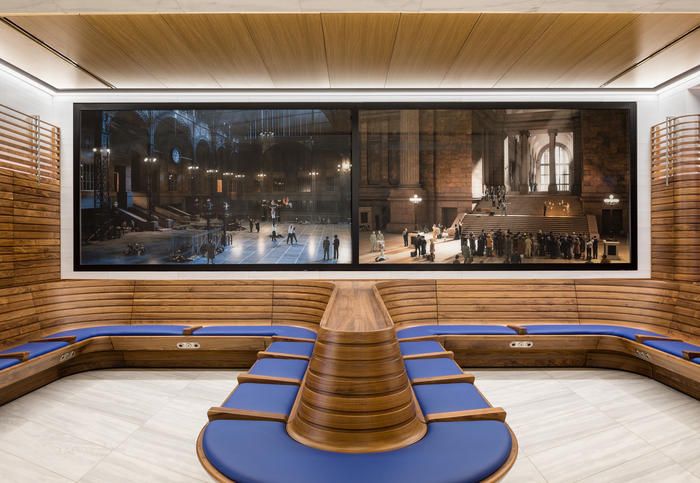
1 March 1914and2 March 1914, from Penn Station’s Half Century, 2020 Ceramic ink on glass. One of nine photographic panels from Penn Station’s Half Century Commissioned by Empire State Development in partnership with Public Art FundforMoynihan Train Hall ©Stan Douglas. Courtesy of the artist, Victoria Miro and David Zwirner.Photo: Nicholas Knight, courtesy Empire State Development and Public Art Fund, NY
The original Penn Station stood from 1910 to 1963, bearing witness to decades of historic New York City events. In Douglas’s photo series, some of the scenes depicted include a gathering of Communist party members in 1934, a soldier kissing his lover goodbye before being deployed to fight in World War II, and an impromptu vaudeville show led by legendary singer, comedian, and African-American movie-director Bert Williams in 1914. Douglas searched through archived photographs, newspaper articles, and architectural plans to find these important, but lesser-known moments in Penn’s history, and to bring them back to life. The cinematic quality of Douglas’ images paints Penn Station “as a grand theater for the millions of human dramas that animate civic spaces and endow them with meaning” as the Public Art Fund explains.
Altogether, the three new installations show a reverence for the past, an appreciation for our present, and an optimistic view of New York City’s future. The pieces celebrate what makes New York great, from its people and history to its architecture.
Explore the new Moynihan Train Hall, and see remnants left over from the original Penn Station opened in 1910 by joining us on an upcoming Remnants of Penn Station walking tours led by Untapped New York’s Chief Experience Officer Justin Rivers!
Join Untapped New York’s Cheif Experience Officer Justin Rivers for a virtual talk on the Remnants and Future of Penn Station on January 6th, to learn more about the Moynihan Train Hall and see images from its opening weekend! This talk is organized for Untapped New York Insiders. Not an Insider yet?
Become a member todayand get two months free with code JOINUS, then membership is just $10/month. A video of the tour will also be made available to all our Insiders afterward in the
Video Archivesection of our website. Already an Insider, register here!
Next, check out 10 Public Art Installations in NYC January 2021
Subscribe to our newsletter